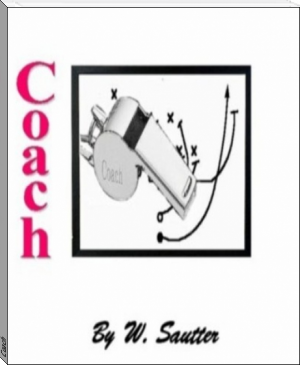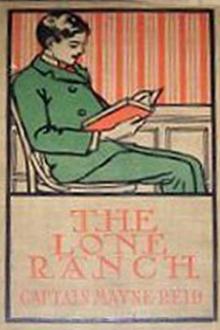The Young Voyageurs: Boy Hunters in the North, Mayne Reid [some good books to read .txt] 📗

- Author: Mayne Reid
Book online «The Young Voyageurs: Boy Hunters in the North, Mayne Reid [some good books to read .txt] 📗». Author Mayne Reid
The hare ran in a side-direction, but it brought her as she passed within range of the party by the sledge. The owl kept above her as she ran. A dozen leaps was all the hare ever made. A loud crack was heard, and she was seen to spring up and fall back upon the snow, dead as a doornail. Like an echo another crack followed—a wild scream rang through the air, and the great white owl fell fluttering to the earth. The reports were not of a rifle. They were the louder detonations of a shot-gun. All eyes were turned towards François, who, like a little god, stood enveloped in a halo of blue smoke. François was the hero of the hour.
Marengo rushed forward and seized the struggling owl, that snapped its bill at him like a watch-man’s rattle. But Marengo did not care for that; and seizing its head in his teeth, gave it a crunch that at once put an end to its flapping.
Marengo was reprieved, and he seemed to know it, as he bounded over the snow, waving his tail, and barking like a young fool.
They all ran up to the hare, which proved to be the “Polar hare” (Lepus glacialis), and one of the largest of its species—not less than fifteen pounds in weight. Its fur, soft and white like swan-down, was stained with red blood. It was not quite dead. Its little heart yet beat faintly, and the light of life was still shining from its beautiful honey-coloured eyes. Both it and the owl were taken up and carried to the sledge, which was once more attached to Marengo, as the party intended to go forward and halt under the shelter of the hill.
“There must be some wood in this quarter,” remarked Norman: “I never knew this sort of hare far from timber.”
“True,” said Lucien, “the Polar hare feeds upon willows, arbutus, and the Labrador tea-plant. Some of these kinds must be near.”
While they were speaking, they had reached the brow of the hill, on the opposite side from where they had ascended. On looking into the valley below, to their great joy they beheld some clumps of willows, and good-sized trees of poplar, birch, and spruce-pine (Pinus alba), and passing down the hill, the travellers soon stood in their midst. Presently was heard the chipping sound of an axe and crash of falling timber, and in a few moments after a column of smoke was seen soaring up out of the valley, and curling cheerfully towards the bright blue sky.
Large as the hare was, she would have made but a meal for our four hungry voyageurs, had they eaten at will. By Lucien’s advice, however, they restrained themselves, and half of her was left for supper, when the “cook” promised to make them hare-soup. The head, feet, and other spare bits, fell to Marengo’s share. The owl, whose flesh was almost as white as its plumage, and, as Norman well knew, most delicate eating, was reserved for to-morrow’s breakfast.
They had pitched their tent with the intention of remaining at that place all night, and continuing their journey next day; but, as it still wanted several hours of sunset, and the strength of all was considerably recruited, they resolved to hunt about the neighbourhood as long as they had light. It was of great importance that they should procure more game. The owl would make but a spare breakfast, and after that where was the next meal to come from? They had had a temporary relief, and while their strength lasted, they must use every effort to procure a further supply. The valley in which their new camp was placed looked well for game. It was a sort of oasis in the Barren Grounds. There was a lake and a considerable skirting of timber around it—consisting, as we have said, of willows, poplars, spruce-pine, and dwarf birch-trees (Betula nana). The Alpine arbutus, whose berries are the food of many species of animals, also grew upon the side of the hills; and the Labrador tea-plant (Ledum palustre) was found upon the low ground around the lake. The leaves of this last is a favourite food of the Polar hare, and our voyageurs had no doubt but that there were many of these animals in the neighbourhood. Indeed, they had better evidence than conjecture, for they saw numerous hare-tracks in the snow. There were tracks of other animals too, for it is a well-known fact that where one kind exists, at least two or three others will be found in the same habitat—all being connected together by a “chain of destruction.”
A singular illustration of this was afforded to Lucien, who remained at the camp while the rest went out hunting. He had gathered some of the leaves of the Labrador tea, and was drying them over the coals, intending to cheer his comrades with a cup of this beverage after supper. The hare-soup was boiling, and the “cook” sat listening to the cheerful sounds that issued from the pot—now and then taking off the lid to examine its savoury contents, and give them a stir. He would then direct his attention to the tea-leaves that were parching in the frying-pan; and, having shifted them a little, felt himself at liberty to look about for a minute or two.
On one of these occasions, while glancing up, his attention was attracted to an object which appeared upon the snow at a short distance from where he sat. A wreath of snow, that had formed under the shelter of the hill, extended all around its base, presenting a steep front in every direction. This front was only two or three feet in height; but the top surface of the wreath was many yards wide—in fact, it extended back until it became blended with the slope of the hill. It was smooth and nearly level, but the hill above was steep, and somewhat rough and rocky. The steep front of the wreath came down within half-a-dozen paces of the fire where Lucien was seated; and it was upon the top or scarpment of it that the object appeared that had drawn his attention. It was a small creature, but it was in motion, and thus had caught his eye.
A single glance showed him that the little animal was a mouse, but of a somewhat singular species. It was about the size of the common mouse, but quite different in colour. The upper half of its body was of a light mahogany tint, while the lower half, including the legs and feet, were of a milky whiteness. It was, in fact, the “white-footed mouse” (Mus leucopus), one of the most beautiful of its kind.
Here and there above the surface of the snow protruded the tops of arbutus-trees; and the little creature was passing from one of these to the other, in search, no doubt, of the berries that remain upon these trees all the winter. Sometimes it ran from point to point like any other mouse, but now and then it would rear itself on its hind-legs, and leap several feet at a single bound! In this it evidently assisted itself by pressing its tail—in which it possesses muscular power—against the snow. This peculiar mode of progression has obtained for it the name of the “jumping mouse,” and among the Indians “deer”-mouse, because its leap reminds them of the bounding spring of the deer. But there are still other species of “jumping mice” in America that possess this power to a greater degree even than the Mus leucopus.
Lucien watched its motions without attempting to interfere with it, until it had got nearly out of sight. He did not desire to do injury to the little creature, nor was he curious to obtain it, as he had already met with many specimens, and examined them to his satisfaction. He had ceased to think of it, and would, perhaps, never have thought of it again, but, upon turning his eyes in the opposite direction, he observed another animal upon the snow. This creature had a far different aspect from the mouse. Its body was nearly a foot in length, although not much thicker than that of the other! Its legs were short, but strong, and its forehead broad and arched convexly. It had a tail more than half the length of the body, hairy, and tapering like that of a cat. Its form was the well-known form of the weasel, and it was, in fact, a species of weasel. It was the celebrated ermine (Mustela erminea), celebrated for its soft and beautiful fur, so long prized as an ornament for the robes of the rich. It was white all over, with the exception of its tail; and that, for about an inch or so at the tip, was covered with black silky hair. On some parts of the body, too, the white was tinged with a primrose yellow; but this tinge is not found in all animals of this species, as some individuals are pure white. Of course it was now in its winter “robes;” but in the summer it changes to a colour that does not differ much from that of the common weasel.
When Lucien first saw it, it was running along the top of the wreath, and coming from the same direction from which the mouse had come. Now and then it paused awhile, and then ran on again. Lucien observed that it kept its nose to the ground, and as it drew nearer he saw that it was following on the same path which the other had taken. To his astonishment he perceived that it was trailing the mouse! Wherever the latter had doubled or made a détour, the ermine followed the track; and where the mouse had given one of its long leaps, there the ermine would stop, and, after beating about until it struck the trail again, would resume its onward course at a gallop. Its manoeuvres were exactly like those of a hound upon the fresh trail of a fox!
Lucien now looked abroad to discover the mouse. It was still in sight far off upon the snow, and, as Lucien could see, busily gnawing at the arbutus, quite unconscious that its greatest enemy was so near. I say greatest enemy, for the Mus leucopus is the natural prey of the Mustela erminea.
The mouse was soon made aware of the dangerous proximity, but not until the ermine had got within a few feet of it. When it perceived the latter it shrunk, at first, among the leaves of the arbutus; but seeing there would be no protection there—as the other was still springing forward to seize it—it leaped up, and endeavoured to escape by flight. Its flight appeared to be in alternate jumps and runs, but the chase was not a long one. The ermine was as active as a cat, and, after a few skips, its claws were struck into the mouse. There was a short, slender squeak, and then a “crunch,” like the cracking of a hazel-nut. This last sound was produced by the teeth of the ermine breaking through the skull of its victim.
Lucien turned round to get hold of his rifle, intending to punish the ermine, although the little creature, in doing what it did, had only obeyed a law of nature. But the boy had also another





Comments (0)